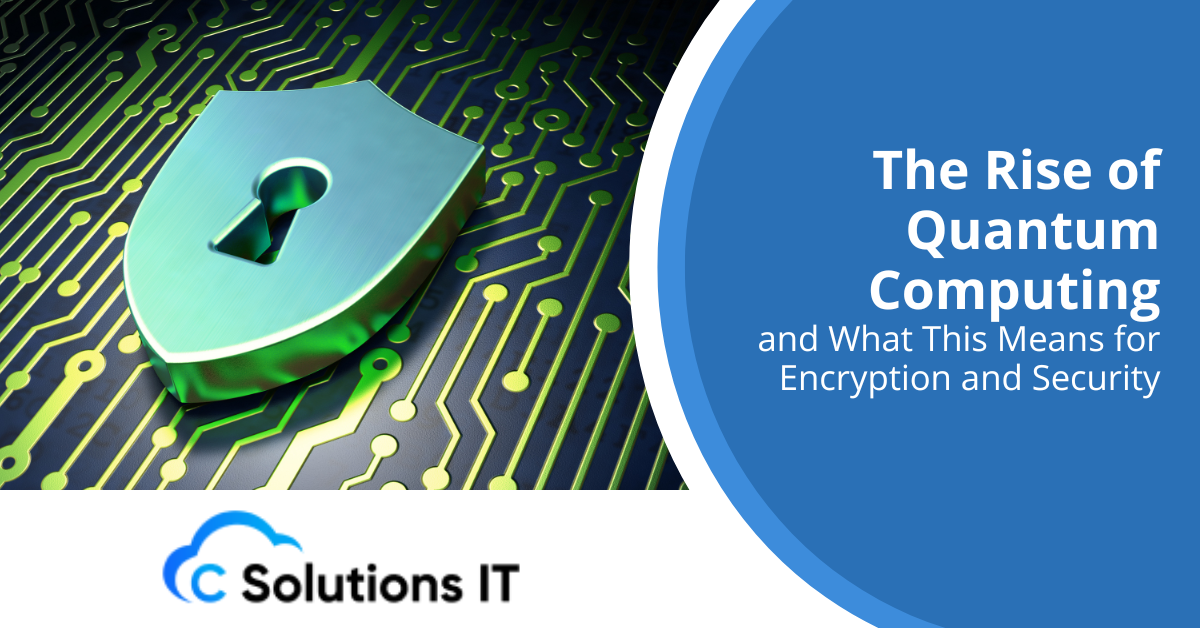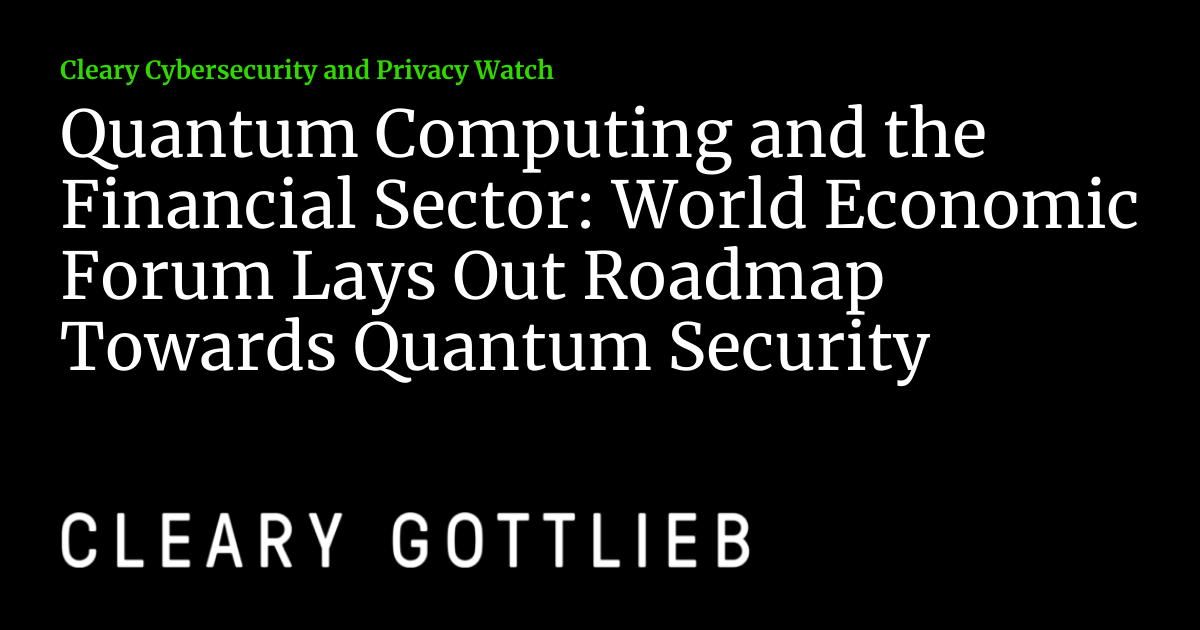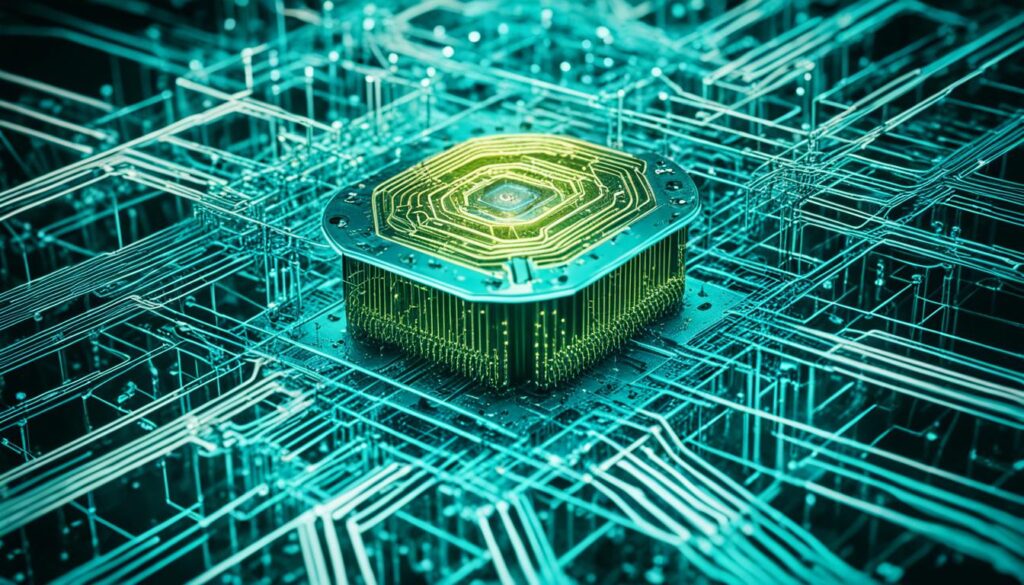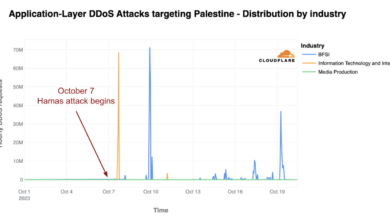
Quantum Computing Will Enable a Safer, More Secure World
Quantum computing will enable a safer more secure world – Quantum computing will enable a safer, more secure world. It’s a bold statement, but the potential is undeniable. Imagine a world where data breaches are virtually impossible, where fraud is detected instantly, and where our most sensitive communications are completely untappable. This isn’t science fiction; it’s the promise of quantum cryptography and the revolutionary advancements in data security offered by quantum computing.
This technology isn’t just about faster calculations; it’s about building a future where our digital lives are protected from the ever-evolving threats of cybercrime and espionage.
From enhancing encryption methods beyond the reach of even the most powerful classical computers to detecting subtle anomalies in massive datasets that signal fraudulent activity, quantum computing is poised to reshape our approach to security. This post explores the multifaceted ways quantum technologies are transforming cybersecurity, fraud detection, secure communication, and national security, paving the way for a more resilient and trustworthy digital landscape.
Enhanced Cybersecurity with Quantum Computing

The advent of quantum computing presents both unprecedented challenges and exciting opportunities for cybersecurity. While quantum computers pose a threat to existing encryption methods, they also pave the way for fundamentally more secure communication and data protection. This enhanced security is achieved through the development of quantum cryptography and quantum-resistant algorithms.Quantum cryptography leverages the principles of quantum mechanics to create secure communication channels that are theoretically unbreakable.
Unlike classical cryptography, which relies on computational complexity to protect data, quantum cryptography’s security is rooted in the laws of physics.
Quantum Key Distribution (QKD)
Quantum key distribution (QKD) is a revolutionary technique for securely exchanging cryptographic keys between two parties. It utilizes the properties of photons, the fundamental particles of light, to transmit a secret key. Any attempt to intercept the key inevitably alters the quantum state of the photons, alerting the communicating parties to the intrusion. This inherent security feature makes QKD significantly more robust than classical key exchange methods vulnerable to eavesdropping and man-in-the-middle attacks.
For example, QKD systems are already being deployed in secure government communications and financial transactions, protecting sensitive data in transit. The use of single photons ensures that any eavesdropping attempt will be detected, thus guaranteeing the security of the shared key.
Quantum-Resistant Cryptographic Algorithms
The threat of quantum computers breaking current encryption standards has spurred the development of quantum-resistant cryptographic algorithms. These algorithms are designed to be secure even against attacks from powerful quantum computers. Examples include lattice-based cryptography, code-based cryptography, and multivariate cryptography. Lattice-based cryptography, for instance, relies on the mathematical hardness of finding short vectors in high-dimensional lattices. This makes it computationally infeasible for even quantum computers to break the encryption.
These algorithms are finding applications in securing various sensitive data, including financial transactions, government communications, and critical infrastructure. They are being integrated into new systems and are also undergoing rigorous testing to ensure their long-term security against future quantum attacks.
Comparison of Classical and Quantum Cryptographic Techniques
| Feature | Classical Cryptography | Quantum Cryptography |
|---|---|---|
| Security Basis | Computational complexity | Laws of physics (quantum mechanics) |
| Key Distribution | Vulnerable to eavesdropping | Secure key distribution via QKD (theoretically unbreakable) |
| Susceptibility to Quantum Computers | Vulnerable to attacks from sufficiently powerful quantum computers | Resistant to attacks from quantum computers |
| Current Deployment | Widely deployed but increasingly vulnerable | Limited deployment but rapidly growing |
Quantum Computing’s Role in Fraud Detection and Prevention
The fight against financial fraud is a constant arms race, with criminals constantly developing new and sophisticated methods. Traditional methods of fraud detection, while effective to a degree, are often slow, inaccurate, and struggle to keep pace with the ever-evolving tactics of fraudsters. Quantum computing, with its unparalleled processing power and ability to analyze complex data sets, offers a powerful new weapon in this fight.
Its potential to revolutionize fraud detection and prevention is significant, promising faster, more accurate, and more proactive systems.Quantum machine learning algorithms possess the ability to identify intricate patterns and anomalies hidden within massive datasets of financial transactions that would be impossible for classical computers to detect. These algorithms leverage the principles of quantum mechanics to explore a far wider range of possibilities and uncover relationships that traditional statistical methods often miss.
This enhanced pattern recognition is crucial for identifying fraudulent activities, especially those involving sophisticated schemes that employ complex layers of obfuscation. The speed and efficiency gains offered by quantum computing are also game-changing, allowing for real-time analysis of transactions, enabling immediate flagging of suspicious activity.
Quantum Machine Learning for Fraud Pattern Identification
Quantum machine learning algorithms, such as quantum support vector machines (QSVMs) and quantum neural networks (QNNs), can analyze vast amounts of transactional data to identify subtle patterns indicative of fraud. These algorithms can uncover non-linear relationships and complex interactions between different data points, leading to a more comprehensive understanding of fraudulent behavior. For example, a QSVM could be trained on a dataset of past fraudulent and legitimate transactions, learning to distinguish between them based on intricate features that might be missed by classical methods.
This would enable the identification of previously unknown fraud patterns, leading to more effective prevention strategies. The speed advantage is also crucial; QNNs, for instance, can potentially train significantly faster than their classical counterparts, allowing for quicker adaptation to emerging fraud techniques.
Quantum computing’s potential to revolutionize cybersecurity is huge, promising encryption methods unbreakable by even the most powerful classical computers. This increased security will be crucial as we move forward with developing complex applications, like those discussed in this insightful article on domino app dev the low code and pro code future , which highlights the need for robust security measures.
Ultimately, a safer, more secure digital world hinges on advancements like quantum computing alongside secure application development practices.
Quantum Computing for Large-Scale Anomaly Detection
The sheer volume of financial transactions processed daily presents a significant challenge for traditional fraud detection systems. Quantum computing’s ability to handle massive datasets with unprecedented speed and efficiency allows for real-time anomaly detection. Anomaly detection algorithms, when implemented on quantum computers, can rapidly scan through millions of transactions, identifying outliers that deviate significantly from established norms. This real-time analysis is critical for preventing fraud before it causes significant financial losses.
For instance, a quantum algorithm could identify unusual transaction patterns, such as a sudden surge in high-value transactions from an unfamiliar location, which might indicate a compromised account.
Improved Accuracy and Speed of Fraud Detection Systems
Quantum computing offers the potential to significantly improve both the accuracy and speed of fraud detection systems. The enhanced pattern recognition capabilities of quantum machine learning algorithms lead to a lower false positive rate, reducing the number of legitimate transactions flagged as fraudulent. This reduces inconvenience for legitimate users while simultaneously increasing the effectiveness of fraud prevention. The speed advantage allows for near real-time analysis, providing immediate alerts for suspicious activities, minimizing the impact of fraudulent transactions.
Consider a scenario where a large-scale credit card fraud ring is attempting to make numerous fraudulent purchases. A quantum-powered fraud detection system could identify and block these transactions almost instantaneously, significantly reducing the financial losses.
Steps in Using Quantum Computing for Fraud Detection
The implementation of quantum computing for fraud detection involves a multi-step process. It’s important to note that this is a developing field, and the exact steps may evolve as the technology matures.
- Data Preparation and Preprocessing: This involves collecting, cleaning, and preparing the transactional data for use in quantum algorithms. This stage is crucial for ensuring the accuracy and reliability of the results.
- Algorithm Selection and Development: Choosing the appropriate quantum machine learning algorithm (e.g., QSVM, QNN) for the specific fraud detection task. This may involve adapting existing algorithms or developing new ones tailored to the unique characteristics of financial data.
- Quantum Algorithm Training: Training the selected algorithm on a labeled dataset of past fraudulent and legitimate transactions. This involves using a quantum computer to optimize the algorithm’s parameters to achieve high accuracy in distinguishing between fraudulent and legitimate activities.
- Deployment and Monitoring: Deploying the trained quantum algorithm on a quantum computer or a hybrid quantum-classical system to analyze real-time financial transactions. Continuous monitoring and refinement of the algorithm are essential to maintain its effectiveness in the face of evolving fraud techniques.
Quantum-Based Secure Communication Networks

Our current communication infrastructure, while remarkably advanced, suffers from inherent vulnerabilities. Traditional encryption methods, for example, rely on the computational difficulty of breaking complex mathematical problems. However, the advent of powerful quantum computers threatens to render these methods obsolete, leaving our sensitive data exposed. Quantum communication networks, however, offer a fundamentally different approach to security, leveraging the laws of quantum mechanics to ensure unbreakable encryption.
This shift promises a future where secure communication is no longer a luxury but a guaranteed right.Current communication networks rely heavily on public-key cryptography, which is vulnerable to attacks from sufficiently powerful quantum computers. Man-in-the-middle attacks, eavesdropping, and data breaches are all significant concerns. Quantum Key Distribution (QKD), a core component of quantum communication networks, addresses these issues by utilizing the principles of quantum mechanics to generate and distribute encryption keys that are theoretically impossible to intercept without detection.
This ensures that even if a quantum computer is used to attempt decryption, the very act of eavesdropping will alter the quantum state of the communication, alerting the sender and receiver to the intrusion.
Vulnerabilities of Current Communication Networks and Quantum Solutions
Classical communication networks rely on mathematical algorithms for encryption. The security of these algorithms is based on the assumption that certain mathematical problems are computationally hard to solve with classical computers. However, quantum computers could potentially solve these problems efficiently, rendering current encryption methods ineffective. For instance, Shor’s algorithm, a quantum algorithm, can efficiently factor large numbers, undermining the security of widely used RSA encryption.
Quantum Key Distribution (QKD) provides a solution by using the principles of quantum mechanics to create encryption keys that are provably secure against eavesdropping. Any attempt to intercept the key will inevitably alter the quantum state, alerting the legitimate parties. Furthermore, quantum technologies like quantum repeaters are being developed to extend the range of secure quantum communication, overcoming the current distance limitations of QKD.
Comparison of Classical and Quantum Communication Networks
| Feature | Classical Communication Networks | Quantum Communication Networks |
|---|---|---|
| Security | Relies on computationally hard problems; vulnerable to quantum computer attacks. | Based on the laws of quantum mechanics; theoretically unbreakable. |
| Key Distribution | Uses public-key cryptography; susceptible to man-in-the-middle attacks. | Uses Quantum Key Distribution (QKD); detects eavesdropping. |
| Scalability | Relatively easy to scale; extensive infrastructure already in place. | Currently limited by distance and technological maturity; requires further development. |
| Cost | Relatively low cost for infrastructure and implementation. | High initial investment in infrastructure and equipment. |
Hypothetical Quantum-Secure Communication Network Design
A hypothetical quantum-secure communication network could be designed using a hybrid approach. The backbone network would consist of fiber optic cables connecting quantum repeaters strategically placed across geographical locations. These repeaters would extend the range of QKD, enabling secure key distribution over long distances. At each end point, quantum devices would be integrated with classical communication infrastructure.
The security protocols would involve the use of QKD for key generation and distribution, combined with post-quantum cryptography for data encryption. The network would incorporate robust error correction and detection mechanisms to account for imperfections in quantum channels. This architecture aims to combine the security advantages of quantum communication with the scalability and practicality of existing classical networks.
The system would constantly monitor for anomalies, indicating potential eavesdropping attempts.
Advantages, Disadvantages, and Applications of Quantum Communication Networks
| Aspect | Advantages | Disadvantages | Applications |
|---|---|---|---|
| Security | Unbreakable encryption; detection of eavesdropping. | High initial cost; technological limitations. | Government and military communications; financial transactions; healthcare data transfer. |
| Performance | Potentially faster communication speeds (with future advancements). | Limited range currently; requires quantum repeaters for long distances. | High-frequency trading; real-time data streaming; scientific research. |
| Scalability | Potential for scalability with advancements in quantum repeaters and network technology. | Current infrastructure is limited and costly. | Global communication networks; large-scale data centers. |
Quantum Computing for Secure Data Storage and Management

The promise of quantum computing extends far beyond faster calculations; it offers a revolutionary approach to data security. Traditional encryption methods, while effective now, are vulnerable to the increasing power of classical computers and the potential threat of quantum computers breaking them. Quantum technologies, however, offer a pathway to truly secure data storage and management, addressing vulnerabilities that classical systems simply cannot overcome.
This involves leveraging the unique properties of quantum mechanics to create unbreakable encryption and robust access control mechanisms.Quantum technologies can significantly enhance data storage security by employing quantum encryption and advanced access control. Quantum Key Distribution (QKD), for example, uses the principles of quantum mechanics to establish a secret key between two parties. Any attempt to intercept the key would inevitably alter the quantum state, alerting the communicating parties to the intrusion.
This ensures that the shared key remains secret and secure, forming the basis for unbreakable encryption. Furthermore, quantum access control mechanisms can leverage quantum states to restrict access to sensitive data, allowing only authorized users with the correct quantum keys to retrieve the information. This surpasses classical access control methods by eliminating the possibility of unauthorized key duplication or decryption.
Quantum Encryption and Access Control Mechanisms
Quantum encryption leverages the fundamental principles of quantum mechanics, such as superposition and entanglement, to create cryptographic keys that are fundamentally impossible to copy or intercept without detection. This eliminates the risk of unauthorized access, a significant advancement over classical encryption techniques. For instance, QKD systems use single photons to transmit encryption keys. Any attempt to measure these photons would disturb their quantum state, instantly revealing the eavesdropping attempt.
Access control, in a quantum context, could involve using quantum states as unique identifiers, ensuring that only individuals possessing the specific quantum state can access the encrypted data. This provides a level of security unattainable with classical methods.
Improving Data Integrity and Preventing Data Breaches
Quantum computing offers significant potential for enhancing data integrity and preventing data breaches. Quantum-resistant hashing algorithms, for example, can generate unique fingerprints for data, ensuring that any unauthorized alteration will be immediately detected. This provides a strong mechanism for verifying data authenticity and preventing data manipulation. Moreover, quantum-based error correction codes can significantly improve data reliability and resilience against various forms of corruption, both accidental and malicious.
These codes leverage quantum entanglement to detect and correct errors, ensuring data integrity even in the presence of noise or attacks. This contrasts sharply with classical error correction, which is less efficient and more susceptible to sophisticated attacks.
Quantum-Resistant Storage Solutions
Post-quantum cryptography is actively being developed to address the threat of quantum computers breaking current encryption standards. Several promising quantum-resistant algorithms, such as lattice-based cryptography, code-based cryptography, and multivariate cryptography, are being explored. These algorithms are designed to withstand attacks from both classical and quantum computers, providing long-term security for data storage. These algorithms are being incorporated into new storage solutions, offering a pathway towards a future where data is secure against both present and future threats.
For example, companies are developing quantum-resistant hard drives and cloud storage solutions, implementing these algorithms to protect sensitive data.
Visual Representation of Quantum Data Protection
Imagine a data vault surrounded by a quantum entanglement field. Only those possessing the correct quantum key – a specific entangled quantum state – can unlock the vault. Any attempt to breach the field or access the vault without the key would disrupt the entanglement, immediately triggering an alert and preventing unauthorized access. This visualization represents the fundamental principle of quantum encryption: the inherent security provided by the laws of quantum mechanics, making unauthorized access practically impossible.
Quantum Computing in National Security and Defense
The intersection of quantum computing and national security is rapidly evolving, promising revolutionary advancements but also presenting significant challenges. Quantum computers’ unparalleled processing power offers the potential to dramatically reshape intelligence gathering, cryptography, and the protection of critical infrastructure, while simultaneously introducing new vulnerabilities that require careful consideration. This exploration delves into the multifaceted implications of this emerging technology on national security.Quantum computing’s potential to revolutionize national security stems from its ability to tackle computationally intractable problems that are currently beyond the reach of classical computers.
This transformative power has profound implications for both offensive and defensive capabilities.
Cryptography and Intelligence Gathering
Quantum computers pose a significant threat to current encryption methods, particularly those based on the difficulty of factoring large numbers (RSA) or the discrete logarithm problem (ECC). These algorithms, widely used to secure sensitive government communications and data, could be broken by sufficiently powerful quantum computers, jeopardizing national security. However, quantum computing also offers the potential for post-quantum cryptography, developing new encryption algorithms resistant to attacks from both classical and quantum computers.
This involves exploring alternative mathematical problems that are believed to be hard for both types of computers, such as lattice-based cryptography or code-based cryptography. Furthermore, quantum computing could significantly enhance intelligence gathering capabilities by accelerating the analysis of vast datasets, identifying patterns and anomalies that would be impossible to detect using classical methods. Imagine analyzing satellite imagery to identify hidden military installations or deciphering intercepted communications with unprecedented speed and accuracy.
This increased analytical power could provide a crucial advantage in national security operations.
Securing Critical Infrastructure
Critical infrastructure, encompassing power grids, communication networks, and financial systems, relies heavily on robust cybersecurity. Quantum computing can enhance this security in several ways. For example, quantum key distribution (QKD) offers a fundamentally secure method for exchanging encryption keys, leveraging the principles of quantum mechanics to detect eavesdropping attempts. The implementation of QKD could safeguard sensitive communications within critical infrastructure, ensuring the integrity and confidentiality of data transmission.
Additionally, quantum computing can improve anomaly detection systems by identifying subtle patterns indicative of cyberattacks or system failures. This proactive approach to security could prevent significant disruptions and damage to critical infrastructure. Consider the potential for early detection of malicious activity within a power grid, preventing widespread blackouts.
Ethical Considerations, Quantum computing will enable a safer more secure world
The application of quantum computing in national security raises complex ethical considerations. The potential for misuse, including the development of more powerful offensive cyberweapons or the erosion of privacy through enhanced surveillance capabilities, requires careful consideration. Establishing clear ethical guidelines and international agreements governing the development and deployment of quantum technologies for national security purposes is paramount. Transparency and accountability are crucial to prevent the technology from being weaponized or used in ways that violate human rights.
The potential for an arms race in quantum computing capabilities also necessitates proactive international cooperation and dialogue.
Benefits and Risks of Quantum Computing for National Security
Deploying quantum computing technologies for national security presents both significant benefits and substantial risks. The benefits include enhanced cryptography, improved intelligence gathering, and strengthened cybersecurity for critical infrastructure. However, the risks include the potential for adversaries to develop quantum computers that can break current encryption standards, leading to widespread data breaches. Furthermore, the development of quantum-enhanced cyberweapons could escalate conflicts and destabilize global security.
A balanced approach is needed, prioritizing the development of post-quantum cryptography, responsible research practices, and international cooperation to mitigate the risks while harnessing the potential benefits of this transformative technology. A key challenge lies in striking a balance between leveraging the advantages of quantum computing for national security while preventing its misuse and ensuring global stability.
Quantum-resistant Infrastructure Development
The looming threat of quantum computers capable of breaking widely used encryption algorithms necessitates a proactive approach to securing our digital infrastructure. Building quantum-resistant infrastructure isn’t just about replacing current systems; it’s about fundamentally re-architecting our digital world to withstand the power of future quantum computing. This requires a multi-faceted strategy encompassing algorithm updates, hardware upgrades, and a shift in security paradigms.Existing infrastructure, particularly systems relying on public-key cryptography like RSA and ECC, is highly vulnerable to attacks from sufficiently powerful quantum computers.
These algorithms, currently underpinning secure communication, data storage, and authentication across countless applications, will become easily breakable once large-scale quantum computers become a reality. Quantum-resistant cryptography (also known as post-quantum cryptography) offers a solution by employing algorithms designed to resist attacks from both classical and quantum computers.
Vulnerable Infrastructure Components and Mitigation Strategies
Several key infrastructure components are particularly vulnerable. Public Key Infrastructure (PKI) systems, which rely heavily on RSA and ECC for digital certificates and authentication, are prime targets. Secure communication channels using TLS/SSL protocols, widely employed for securing web traffic and other online transactions, are also at risk. Database systems employing encryption for data at rest and in transit are similarly vulnerable.
Quantum-resistant solutions mitigate these vulnerabilities by replacing the vulnerable algorithms with quantum-resistant alternatives. For example, lattice-based cryptography, code-based cryptography, and multivariate cryptography offer strong security against known quantum attacks and can replace RSA and ECC in PKI and TLS/SSL implementations. Similarly, quantum-resistant hashing algorithms can enhance data integrity and authentication mechanisms.
Integrating Quantum-Resistant Algorithms into Existing Infrastructure
Integrating quantum-resistant algorithms into existing infrastructure is a complex process requiring careful planning and phased implementation. It begins with identifying systems that rely on vulnerable cryptographic algorithms. A thorough security audit is crucial to pinpoint these vulnerabilities. Next, suitable quantum-resistant algorithms are selected based on security requirements, performance considerations, and compatibility with existing systems. The selected algorithms are then integrated into the software and hardware components of the target systems.
This may involve updating software libraries, modifying application code, and potentially upgrading hardware to support the new algorithms’ computational demands. The transition should be carefully managed to minimize disruption and ensure seamless operation during the upgrade. For instance, a phased rollout approach, starting with less critical systems and gradually expanding to core infrastructure, can mitigate risks.
Upgrading Existing Infrastructure to Become Quantum-Resistant
Upgrading existing infrastructure to become quantum-resistant involves a multi-stage process. First, a comprehensive assessment of the current infrastructure identifies all systems and applications using vulnerable cryptographic algorithms. This includes evaluating dependencies, interoperability, and potential impact on existing workflows. Next, a selection process determines which quantum-resistant algorithms best fit the specific needs of each system. This considers factors like security level, performance overhead, and implementation complexity.
The chosen algorithms are then integrated into the systems, requiring updates to software libraries, application code, and potentially hardware components. Rigorous testing and validation ensure that the upgraded systems maintain functionality and offer the desired level of quantum resistance. Finally, a comprehensive monitoring and maintenance strategy is implemented to detect and address any emerging vulnerabilities or performance issues.
For example, a bank might begin by upgrading its less critical internal systems before tackling its core transaction processing infrastructure.
Best Practices for Developing Quantum-Resistant Infrastructure
The importance of a well-defined strategy cannot be overstated. A successful transition requires careful planning and execution. Here are some best practices:
- Conduct a thorough security assessment to identify vulnerabilities.
- Select quantum-resistant algorithms based on rigorous security analysis and performance considerations.
- Adopt a phased approach to minimize disruption and risk during the upgrade process.
- Implement robust testing and validation procedures to ensure functionality and security.
- Establish a comprehensive monitoring and maintenance plan to address emerging issues.
- Collaborate with industry partners and standardization bodies to share best practices and coordinate efforts.
- Invest in training and education to build expertise in quantum-resistant cryptography.
- Stay informed about the latest advancements in quantum computing and quantum-resistant cryptography.
Closure
The future of security is quantum. While challenges remain in the development and widespread adoption of these technologies, the potential benefits are too significant to ignore. The ability to create unbreakable encryption, detect fraud with unprecedented accuracy, and build truly secure communication networks represents a paradigm shift in how we protect our data and ourselves in the digital age.
Quantum computing isn’t just about improving existing security measures; it’s about fundamentally redefining what security means in a world increasingly reliant on digital infrastructure. As we move forward, embracing the potential of quantum computing is crucial to building a safer and more secure future for everyone.
FAQ Resource: Quantum Computing Will Enable A Safer More Secure World
What are the biggest challenges in implementing quantum computing for security?
The biggest challenges include the high cost and complexity of quantum computers, the need for specialized infrastructure, and the potential for quantum computers to be used for malicious purposes as well.
How long until quantum computing is widely used for security?
It’s difficult to give a precise timeline, but we’re already seeing the development and implementation of quantum-resistant algorithms and some aspects of quantum cryptography. Widespread adoption will likely be a gradual process over the next decade or more.
Will quantum computing make current encryption obsolete?
Yes, powerful enough quantum computers could break many widely used encryption methods. This is why the development of quantum-resistant algorithms is so critical.
Is quantum computing only beneficial for governments and large corporations?
While large organizations will likely be early adopters, the benefits of quantum-enhanced security will eventually extend to individuals and smaller businesses as the technology matures and becomes more accessible.





